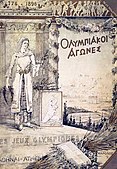
Ty Cobb
Ty Cobb was suspended for ten days during the 1912 baseball season. Cobb was disciplined for beating Claude Lucker, a fan who had been heckling him during the four-game series between Cobb’s Detroit Tigers and the New York Yankees. Cobb was ejected from the game on May 15, 1912, and American League president Ban Johnson suspended him indefinitely. Cobb’s teammates took his side, and after defeating the Philadelphia Athletics on May 17, told Johnson that they would not play again until Cobb was reinstated. Johnson refused to do so. Seeking to avoid a $5,000 fine, owner Frank Navin told manager Hughie Jennings to recruit a team; he did so. Facing the Athletics, baseball’s World Champions, the replacement players, joined by Jennings and his coaches, lost 24–2, after which Cobb persuaded his teammates to return. They and Cobb were fined, but Navin paid. The walkout was baseball’s first major league strike; it had little effect, but teams put additional security into stadiums. (Full article…)
Recently featured: .mw-parser-output .hlist dl,.mw-parser-output .hlist ol,.mw-parser-output .hlist ul{margin:0;padding:0}.mw-parser-output .hlist dd,.mw-parser-output .hlist dt,.mw-parser-output .hlist li{margin:0;display:inline}.mw-parser-output .hlist.inline,.mw-parser-output .hlist.inline dl,.mw-parser-output .hlist.inline ol,.mw-parser-output .hlist.inline ul,.mw-parser-output .hlist dl dl,.mw-parser-output .hlist dl ol,.mw-parser-output .hlist dl ul,.mw-parser-output .hlist ol dl,.mw-parser-output .hlist ol ol,.mw-parser-output .hlist ol ul,.mw-parser-output .hlist ul dl,.mw-parser-output .hlist ul ol,.mw-parser-output .hlist ul ul{display:inline}.mw-parser-output .hlist .mw-empty-li{display:none}.mw-parser-output .hlist dt::after{content:”: “}.mw-parser-output .hlist dd::after,.mw-parser-output .hlist li::after{content:” · “;font-weight:bold}.mw-parser-output .hlist dd:last-child::after,.mw-parser-output .hlist dt:last-child::after,.mw-parser-output .hlist li:last-child::after{content:none}.mw-parser-output .hlist dd dd:first-child::before,.mw-parser-output .hlist dd dt:first-child::before,.mw-parser-output .hlist dd li:first-child::before,.mw-parser-output .hlist dt dd:first-child::before,.mw-parser-output .hlist dt dt:first-child::before,.mw-parser-output .hlist dt li:first-child::before,.mw-parser-output .hlist li dd:first-child::before,.mw-parser-output .hlist li dt:first-child::before,.mw-parser-output .hlist li li:first-child::before{content:” (“;font-weight:normal}.mw-parser-output .hlist dd dd:last-child::after,.mw-parser-output .hlist dd dt:last-child::after,.mw-parser-output .hlist dd li:last-child::after,.mw-parser-output .hlist dt dd:last-child::after,.mw-parser-output .hlist dt dt:last-child::after,.mw-parser-output .hlist dt li:last-child::after,.mw-parser-output .hlist li dd:last-child::after,.mw-parser-output .hlist li dt:last-child::after,.mw-parser-output .hlist li li:last-child::after{content:”)”;font-weight:normal}.mw-parser-output .hlist ol{counter-reset:listitem}.mw-parser-output .hlist ol>li{counter-increment:listitem}.mw-parser-output .hlist ol>li::before{content:” “counter(listitem)”a0 “}.mw-parser-output .hlist dd ol>li:first-child::before,.mw-parser-output .hlist dt ol>li:first-child::before,.mw-parser-output .hlist li ol>li:first-child::before{content:” (“counter(listitem)”a0 “}





